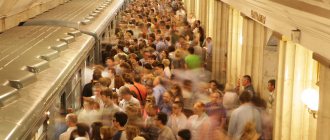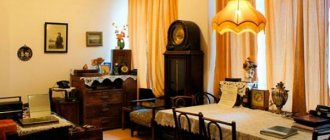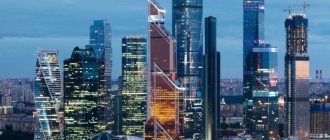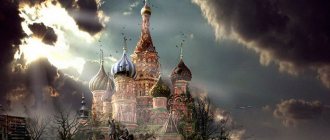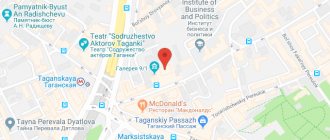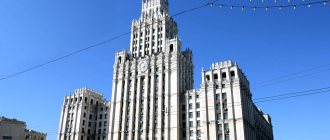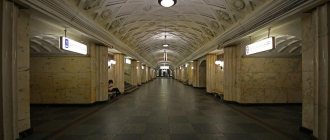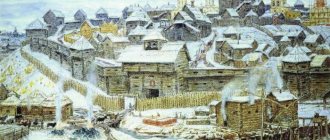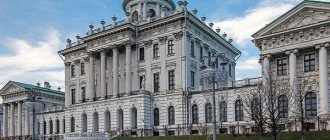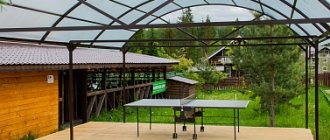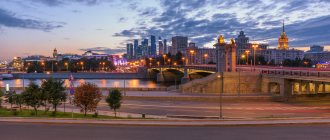Moscow is an amazing city with rich architecture. Many people criticize her for the lack of a certain style, but perhaps this is precisely the highlight of the Russian capital. Here, an old temple can stand among modern high-rise buildings, and a Gothic building can stand out against the backdrop of buildings in the classicist style.
Every day we pass by a huge number of such structures and are not even aware of their unusual history. It will not be possible to cover them all at once, so the online publication m24.ru has selected a dozen architectural finds whose construction history you might not know.
Isakov's apartment building on Prechistenka
Photo gallery
During a missile test, the Indian military destroyed a space satellite that was in low Earth orbit, Prime Minister Narendra Modi announced in an address to the nation.1 of 6
Today it is an apartment building on Prechistenka. It was built in 1904–1906 according to the design of the architect Lev Kekushev. The building is one of the best Moscow Art Nouveau buildings and is an example of this style of the early twentieth century. It is famous for its expressive facade and rich decor.
Back in 1812, there was a two-story classic stone house with a garden and a couple of service rooms. This picture has not changed for a century. And so, in the early 1900s, the old building was demolished, and a 5-6-story apartment building was erected in its place.
The most amazing thing about the building is that during its construction, the architect Kekushev strove for maximum asymmetry and used all the possibilities of the site for this.
His idea was a success: the part of the building facing the courtyard has six floors, and the part facing the street has only five. The main staircase divides the building into front and back parts, which are offset from each other by half a floor in height. Thanks to this, it was possible to enter the apartment from any landing. The window sashes on each floor have their own pattern. The side facades of the house are simpler, and the facades facing the courtyards are completely undecorated.
Exotics of distant countries
Spanish courtyard on Vozdvizhenka - passions for Spain
Morozov Mansion (Spanish Compound)
- Years of construction: 1895–1899
- Architect: V. Mazyrin
Carved cornice, shells on the walls, twisted columns and drainpipes - the mansion, unusual for classical Moscow of the 19th century, still attracts the gaze of passers-by.
It once belonged to Arseny Morozov, the cousin of the famous philanthropist Savva Morozov. The building, similar to a fairy-tale palace in the neo-Moorish style, appeared here thanks to the imagination of its owner. The palace was built by A. Morozov's friend, architect Viktor Mazyrin. The prototype was the Pena Palace in Sintra (Portugal) and the shell house in Salamanca.
Contemporaries did not appreciate the architectural wonder and laughed at the owner of the house. According to rumors, even A. Morozov’s own mother spoke about her son’s idea: “Before, I was the only one who knew that you were a fool, but now all of Moscow will know.” But the palace has taken root in Moscow and now it is one of the brightest architectural masterpieces of the turn of the 19th-20th centuries.
Now the mansion is under the jurisdiction of the Ministry of Foreign Affairs (Reception House of the Government of the Russian Federation). You can’t just get inside, although there is something to see there.
Address: Vozdvizhenka, 16/3. 2 minutes from the station m. Arbatskaya.
Tea house on Myasnitskaya - Chinese style
Perlov's tea house
- Years of construction: 1890–1893
- Architect: R. Klein, design by K. Gippius
The Chinese-style tea house is the main decoration of Myasnitskaya Street in Moscow. It doesn’t look exotic in Moscow, as if we were not in Moscow at all, but in distant and mysterious China. This architectural style is called Chinoiserie (meaning "Chinese").
Join our community:
The building belonged to S.V. Perlov, a representative of the famous Perlov tea dynasty, owner of tea shops and a tea factory in Moscow.
The house was built by architect R. Klein in the late Renaissance style. A little later, Karl Gippius rebuilt it in the Chinese style - he erected a pagoda turret on the roof, decorated the main entrance, facade and interiors with Chinese patterns with gilded dragons and other strange animals, floral patterns, and bright ceramic details. Decorative items, decorations and finishing materials were ordered from China.
As a result, we got such an interesting house in the “Chinese box” style, which even now pleases the eye and hospitably invites you to come inside and buy the most delicious tea in Moscow. As before, one of the best tea shops in Moscow is open there. If you're nearby, be sure to take a look inside to see the preserved interior with painted panels and stunningly beautiful ceilings.
The tea store website has a virtual tour of the room.
Address: Myasnitskaya st., 19. Nearest station. m. Turgenevskaya.
Gothic house on Baumanskaya
Residential building in Gothic style on Baumanskaya
- Years of construction: 1910-1914
- Architect: V. Mazyrin
The former apartment building of the peasant Frolov, is now quite a residential four-story Moscow house. Despite the low-rise building, the house was not demolished, and, I hope, will not be demolished, although the current mayors do not like low-rise buildings, preferring to build up Moscow with giant giants.
The Gothic house was built by Viktor Mazyrin, the author of the Morozov mansion on Vozdvizhenka.
The choice of a Gothic theme is a tribute to the past of the Basmanny district, where the German settlement was previously located.
You can go inside. There are colorful stained glass windows on the stairwells. The house does not have security status. It has only 3 apartments and 4 floors. I wonder what kind of lucky people live there.
Address: Baumanskaya st., 23. St.
m. Baumanskaya.
Flat houses on Presnensky Val
Photo: m24.ru/Mikhail Sipko
On Presnensky Val, not far from the Ulitsa 1905 Goda metro station, there are “flat” houses - at numbers 36 and 38. Of course, in fact, these are the most ordinary buildings, at first glance even nothing not remarkable. However, the angle between the front and side of both houses is so small that from certain angles the buildings appear completely flat.
Two-entrance residential building No. 36 was built in 1910. According to one version, the land plot allocated for construction was of such a shape that the architect had to make one of the sides of the house in the form of a beveled corner. When you look at it from the right side, the illusion arises that the house is drawn on a sheet of plywood supported by something from behind.
The 38th house looks more spacious. True, looking at its facade, it seems as if the back part of the building was cut off with something. Even now, when the building has aged and acquired a somewhat neglected appearance, it looks extraordinary.
Malevich's Nano-Suprematism
Photo: Shutterstock.com
The Moscow School of Management "Skolkovo" is located very close to Moscow, just a kilometer from the Moscow Ring Road along the Skolkovskoye Highway and literally on the border with the Mozhaisk district. This building cannot exactly be called ordinary, because the inspiration for the architect was the painting “Suprematism” by Kazimir Malevich. The spirit and philosophy of geometric abstractionism is here on the street. Novaya, 100, in the workers' village of Zarechye - in every centimeter.
We can say that from above, this complex is a large-scale monument to the artist’s work: the campus contains educational and office premises, two hotels, a fitness club, a retail zone and a cottage village for teachers. It is likely that bold lines, shapes and colors should help Skolkovo residents think creatively and unleash their creative potential.
Lukutins' estate
Photo gallery
During a missile test, the Indian military destroyed a space satellite that was in low Earth orbit, Prime Minister Narendra Modi announced in an address to the nation.1 of 3
The Lukutin estate, or, as it is also called, the house of three eras, is not an ordinary building. It was built in the 18th century in Vishnyakovsky Lane. At that time it was a three-story house owned by the famous merchant Lukutin, the creator of the production of the famous painted boxes that are still made to this day.
In 1910, the owner wanted to turn the building into an apartment building, and according to his order, architect Pyotr Ushakov added another floor. Thus, the classic manor became a four-story residential building. And already in our time, in the 1980s, five more floors were added to the house.
And so it happened that in an ordinary estate three eras grew together at once: the 18th century, the beginning of the 20th century and the end of the 20th century. And if you look closely at the building, you can see all the stages of its architectural growth.
Pizza that the Pentagon never dreamed of
Photo: Shutterstock.com
Our answer to the American Pentagon - the building of the Military Academy of the General Staff of the Russian Armed Forces - has been located at 100 Vernadsky Avenue since 1988, and has the shape of a regular octagon - an octagon. However, especially observant residents of the Troparevo-Nikulino district are convinced that the building was built according to the pizza principle: the Academy’s round courtyard is divided into triangular sectors, and the main building itself is surrounded by a square “box” of educational buildings.
Cathedral of Christ the Savior
Photo: m24.ru/Yulia Ivanko
The Cathedral of Christ the Savior is the largest cathedral of the Russian Orthodox Church, accommodating up to ten thousand people. It also has a rich history.
The cathedral was built 130 years ago. It was erected in 1883 as a temple-monument dedicated to the Patriotic War of 1812. Its ceremonial foundation took place on Vorobyovy Gory in October 1817, but the project was not implemented due to problems associated with the fragility of the soil. In 1825, Nicholas I ordered the suspension of all work, and construction stopped.
Seven years later, the emperor approved a new design for the temple and personally chose a location for it - on the banks of the Moscow River. The temple took almost 44 years to build, and regular services began in the cathedral in 1883. Coronations took place there, national holidays and anniversaries were celebrated. For example, the 500th anniversary of the death of St. Sergius of Radonezh, the 100th anniversary of the Patriotic War of 1812, the 300th anniversary of the House of Romanov.
In the early 1920s, the cathedral was captured by renovationists, and almost a dozen years later, in 1931, it was closed. By decision of the Soviet government, the temple was blown up on December 5 of the same year. Only part of the external white stone bas-reliefs, later mounted into the wall of the Donskoy Monastery, has survived.
It was planned to build the Palace of Soviets on the site of the building. However, the plans were never implemented due to the Great Patriotic War. Upon completion, the foundation of the building was used for an outdoor swimming pool, called “Moscow”.
In September 1994, the capital's government decided to recreate the Cathedral of Christ the Savior, returning it to its former appearance. The cathedral was built in less than six years. In 2000, all internal and external finishing work was completed.
Sights of Moscow: 50 most beautiful places in the capital
Moscow has thousands of historical and architectural monuments that deserve close attention. We have compiled a list of the most interesting sights of the capital, which will allow you to get to know and love this beautiful city. It is unforgivable to visit Moscow and not see at least a few places from this list.
Red Square The history of Russia's most famous square began in 1493, when a strip 240 meters wide was cleared under the Kremlin walls to increase trade space. Initially it was called Pozhar or Torg, then Trinity, since the Trinity Church stood in its southern part. Red Square became red after the construction of St. Basil's Cathedral. The modern appearance began to emerge in the second half of the 19th century, with the appearance of large-scale structures - the Middle and Upper Trading Rows, the building of the Historical Museum. The square acquired serious ideological weight after the revolution.
Moscow Kremlin The fortress in the center of the capital has enormous historical, artistic and socio-political significance. The first wooden structures appeared here in 1264, when Moscow appanage princes built their residence on this territory. The Kremlin, as we know it now, began to take shape during the reign of Ivan III, when the Tsar decided to build a large-scale fortification structure on Borovitsky Hill. The ruler hired the most famous architects from Milan, and they fully lived up to the reputation of the best builders in Europe.
GUM Modern GUM has taken the place of the Upper Trading Rows on Red Square. According to the architect's plan, New Rows was to become the most technically advanced and prestigious department store in the Russian style. Alexander Pomerantsev succeeded - a shopping complex with its own power plant, hairdressers, artesian wells, bank branches and other useful options created a sensation among the townspeople. GUM became a self-sufficient block of 16 separate buildings with streets and glass roofs. Today it is the most prestigious store in the country with an interesting history. ADDRESS:
Red Square, 3 (metro station Okhotny Ryad)
Cathedral of the Kazan Icon of the Mother of God on Red Square The temple was built in honor of the liberation of Moscow from Polish invaders in 1625. The cathedral received its name from the icon of Our Lady of Kazan - the main shrine of the people's militia. The church burned, was rebuilt, expanded. During the Soviet period, during the Stalinist reconstruction of Manezhnaya Square, the cathedral was dismantled. However, before this, the architect Baranovsky made measurements and photographed all the details of the temple. The initiative of a caring specialist made it possible, years later, to restore the building with maximum historical authenticity. ADDRESS:
Nikolskaya st., 3 (metro station Okhotny Ryad)
Iversky (Voskresensky) Gates The original Voskresensky Gates with two arches were built as part of the Kitaygorod wall in 1535 for a defensive purpose - they were intended to repel enemy attacks from advantageous positions. In 1556, Ivan the Terrible installed a cage with lions at the gate, donated by the King of England, after which the gate began to be called the Lion Gate. In 1669, a chapel was built above the gate specifically for the icon of the Iveron Mother of God. The Iveron Chapel was demolished in 1929, and a figure of a worker was erected in its place. In 1993, the gate was reconstructed and the chapel was restored to its original appearance. ADDRESS:
Voskresenskie Vorota Ave., 1A (metro station Okhotny Ryad)
State Historical Museum The date of establishment of the State Historical Museum is considered to be February 9, 1872. On this day, Alexander II signed the document on its foundation. This is how a majestic building appeared on Red Square, built specifically to house unique exhibits from the Russian treasury. Now in 39 halls all stages of the history of the state are presented - from the Stone Age to the present day. The total exhibition area is 4 thousand square meters; in total, the collections contain about 250 thousand exhibits. ADDRESS:
Voskresenskie Vorota Ave., 2 (metro station Okhotny Ryad)
Mausoleum of V.I. Lenin Six days after Lenin’s death, on the site of the stands from which the leader spoke to the proletarians, the architect Shchusev built the first wooden tomb in the shape of a cube with two extensions on the sides. In 1925, an international competition was held for the best design of a stone mausoleum, but the construction of a new tomb made of granite and labradorite was again entrusted to Shchusev. Construction was completed in 1930. The general idea of the stone mausoleum was reminiscent of an old building, but it was 4.5 times larger in area and three meters higher. ADDRESS:
Red Square (metro station Okhotny Ryad)
St. Basil's Cathedral The most beautiful and recognizable temple in Russia was built and consecrated in 1561. The cathedral complex includes eleven chapels, which are grouped around the main Church of the Intercession of the Virgin. The Intercession Church was erected in memory of the annexation of Kazan, since the decisive battle with the army of the khan took place on the day of the Intercession of the Virgin. The remaining churches were also named after holidays on which important battles took place. St. Basil's Cathedral is a branch of the historical museum. The site is protected by UNESCO and included in the World Heritage List. ADDRESS:
Red Square, 7 (metro station Okhotny Ryad)
Nikolskaya Street The oldest Moscow street appeared on the city map in the 13th century, connecting the Kremlin with Vladimir, Suzdal and Rostov the Great. It acquired its name later, after the construction of the St. Nicholas the Old Monastery in 1390. Nikolskaya can easily be called the most progressive street in Moscow. It was here that the first printing house in Russia, the printing yard, opened its doors. Here Mstislavets and Fedorov created the first Russian book “Apostle” with imprint. The first secular school in Moscow and the Slavic-Greek-Latin Academy opened on Nikolskaya Street.
Zaryadye Park A new public space, created according to a joint project of American and Russian urbanists in 2021, became the only facility in Russia included by Time magazine in its list of the best places to relax. In addition to organized natural areas, on the territory of Zaryadye there is a large philharmonic hall with almost 2 thousand seats, a hotel complex, a floating observation deck, an ice cave, well-maintained bicycle paths, numerous cafes and souvenir shops. ADDRESS:
st. Varvarka, 6 (metro station Kitay-Gorod)
Kitay-Gorod and Varvarka Street On the territory of Kitay-Gorod there is the oldest street in Moscow - Varvarka. The road to Vladimir began here, along which Dmitry Donskoy returned to the Kremlin after the Battle of Kulikovo. The first mention of the toponym dates back to 1434 - then the street was called differently - Varvarskaya. Now Varvarka begins at Red Square and ends at the Varvarsky Gate. But in ancient times the street ran along the ridge of the hill above the river from the Spassky Gate of the Kremlin. The modern appearance of Varvarka began to take shape after the fire of 1812, when burnt wooden buildings were replaced with stone buildings.
TSUM The history of TSUM began with the registration of the Muir and Merilize trademark by Scottish entrepreneurs in 1857. The first large store, which has no analogues in Russia, was opened under this brand. The commercial building burned down in 1900, but eight years later a new seven-story building in the neo-Gothic style appeared in its place. After the revolution, Muir and Meriliz was nationalized and, under the auspices of Mostorg, the largest department store was opened. In 1953, TSUM introduced a self-service system and installed cash registers, making it the most advanced department store in the Soviet Union. ADDRESS:
st. Petrovka, 2 (metro station Teatralnaya)
Bolshoi Theater The most significant theater in Russia was founded in 1776, when Prince Pyotr Urusov received permission from Catherine II to open and maintain a theater studio. The prince built a theater on Petrovka, but it immediately burned down. Urusov’s work was continued by Michael Maddox, thanks to whom a three-story building under a plank roof with a hall for a thousand seats appeared. But Maddox’s brainchild was also destroyed by fire. The fire did not spare the third theater, built in 1825, but it was restored, increasing the height, reworking the façade decor and changing the configuration - it is this option that has survived to this day. ADDRESS:
Teatralnaya Square, 1 (metro station Teatralnaya)
Moscow City Hall building (former house of the Governor General) The City Hall building was built in 1782 by the architect Kazakov by order of the Governor General of Moscow, Count Chernyshev. In 1790, after the death of the count, the palace in the classicist style became the official residence of Moscow leaders and served this function until 1917. After the revolution, the Moscow City Council was located in it, and in 1939, when Tverskaya Street was expanded, the house was moved to the new red line. In 1946, the building was reconstructed and enlarged, preserving the authentic architectural appearance, but adding Soviet symbols to the decor. ADDRESS:
Tverskaya st., 13 (Tverskaya metro station)
Patriarch's ponds The most mystical ponds in Moscow appeared in the 17th century near the Patriarch's settlement and the residence of Patriarch Hermogenes. Three small reservoirs were dug especially for breeding fish for the patriarchal table - the memory of this was preserved in the name of Trekhprudny Lane. With the abolition of the patriarchate, the fishponds became swampy, and in the first half of the 19th century, two of them were covered with earth, leaving one large Patriarchal pond, around which a cozy square was laid out. During the Soviet period, the decorative reservoir was called Pionersky; the first name returned only after 1990. ADDRESS:
Patriarch's Ponds (metro station Mayakovskaya)
Pashkov House The famous white stone palace in the classicist style was supposedly built according to Bazhenov's design in 1786 and immediately gained fame as the most beautiful building in Moscow. The place for its construction was not chosen by chance - from the hill on which the mansion stands, all the buildings and towers of the Kremlin are visible. This is the only site with such a vista. In 1861, Pashkov’s house became the property of the Rumyantsev Museum, and the library was moved here. After the revolution, it received the status of the country's main book depository, and in 1992 it became the Russian State Library. ADDRESS:
st. Vozdvizhenka, 3/5с1 (metro station Borovitskaya)
Library named after Lenin The history of Leninka began in 1861, when the collection of rare books collected by Rumyantsev was transported from St. Petersburg to Moscow and placed in Pashkov’s house. The unique collection was replenished through gifts and donations, and by 1917 the funds already contained 1,200 thousand copies. Library named after Lenin was created on the basis of the Rumyantsev Museum in 1925. It included the Institute of Library Science and Graduate School. Gradually, the collection increased to 20 million copies, and Leninka acquired the most important scientific and research significance. ADDRESS:
st. Vozdvizhenka, 3/5 (metro station Borovitskaya)
Film studio "MOSFILM" The most famous film studio turned 95 years old. The first Soviet film “On Wings High” was shot here and more than 2.5 thousand films were created, many of which became classics. Outstanding directors worked at Mosfilm: Eisenstein, Pudovkin, Chukhrai, Pyryev, Bondarchuk, Ryazanov and many others. Now on the territory of the film factory there is a museum with unique exhibits. The exhibitions include scenery from famous films, historical costumes, personal items that belonged to great actors, and a collection of vintage cars. ADDRESS:
st. Mosfilmovskaya, 1 (metro station Lomonosovsky Prospekt)
Cathedral of Christ the Savior and Patriarchal Bridge The Cathedral of Christ the Savior was founded in honor of the victory over Napoleon's army in 1812. The best craftsmen of their time worked on the design of the grandiose building in the Russian-Byzantine style. The majestic cathedral was destroyed in 1931 and rebuilt in 1997 with maximum historical accuracy. In 2004, the Patriarchal Bridge was opened, connecting the territory of the temple with the Yakimanskaya, Bersenevskaya and Prechistenskaya embankments. From the surface of the arched structure there are excellent views of the Kremlin, the Peter the Great monument, the Moscow River and the central part of the city. ADDRESS:
st. Volkhonka, 15 (metro station Kropotkinskaya)
Museum of Fine Arts. Pushkin The largest museum of foreign art was founded by Professor Ivan Tsvetaev in 1912. A building in the form of an antique temple in the neoclassical style was built specifically to house the large exhibition, designed by Roman Klein. According to the creator's plan, the enterprise was supposed to perform a teaching function, but after the revolution the institution was transformed into the State Museum. Now the collection includes about 800 thousand exhibits: works of fine art, archaeological finds, casts of ancient statues, objects from Ancient Rome and Egypt. ADDRESS:
st. Volkhonka, 12 (metro station Kropotkinskaya)
Novodevichy Convent One of the most beautiful monastery complexes in Russia was founded in 1524 by decree of Vasily III in honor of the capture of Smolensk. The architectural ensemble includes 14 buildings and a necropolis adjacent to the southern wall, where many representatives of noble families and prominent figures of the Soviet era were buried. The uniqueness of the Novodevichy Convent lies in its preservation. The appearance, formed in the 16th-17th centuries, has not undergone significant changes, which served as the basis for including the site on the UNESCO protected list. ADDRESS:
Novodevichy Ave., 1 (Sportivnaya metro station)
Vorobyovy Gory Vorobyovy Gory is part of a complex of seven Moscow hills and is one of the most picturesque areas of the capital. The main attraction of these places is the observation deck, which offers an amazing view of the city. Lermontov, Tolstoy, Dostoevsky, Blok and Bulgakov looked for inspiration here. Now, according to tradition, wedding processions come here. On Vorobyovy Gory there is a nature conservation park with an ecological trail, a cable car that operates all year round, and ski slopes with jumps and a chair lift. ADDRESS:
Vorobyovy Gory (Vorobyovy Gory metro station)
Luzhniki Stadium Luzhniki is on the list of the most capacious European stadiums - the sports facility can accommodate 81 thousand spectators at a time. During the World Cup, it was the main arena of the country. Now Luzhniki is one of the most popular attractions in Moscow. An observation deck is equipped on the roof of the stage, from which there is an excellent perspective on the Sparrow Hills and other interesting objects. There is also a giant media screen installed here. ADDRESS:
st. Luzhniki, 24, building 1 (metro station Vorobyovy Gory)
Moscow State University named after M.V. Lomonosov Moscow State University was founded in 1755 on the initiative of Shuvalov and Lomonosov. The oldest and largest university in Russia includes 15 research institutes, seven branches, approximately 300 departments, and 43 faculties. Now the university has more than 600 buildings, but its “heart” is located in one of the seven Stalinist towers on Sparrow Hills. This structure is the tallest in the complex - the distance from the foundation to the tip of the spire is 240 meters. Until the early 2000s, the building was the tallest European building. ADDRESS:
Leninskie Gory microdistrict, 1 (University metro station)
Hotel "Ukraine" Hotel "Ukraine" (now owned by the Radisson Collection chain) occupies the last of seven Stalinist skyscrapers on Kutuzovsky Prospekt. Outstanding architects of their time worked on the creation of a complex of three buildings, using the design technology of American skyscrapers as a basis. In 2005, the high-rise building was purchased and restored, preserving the architectural style and authentic decorative elements of the facades. During the renovation process, the new owners left the interiors of public spaces, halls, restaurants, staircases and lobbies unchanged. ADDRESS:
Kutuzovsky Ave., 2/1с1 (Kyiv metro station)
Residential building on Kotelnicheskaya Embankment The first of Stalin's seven high-rise buildings became the most famous residential building in Russia. Its architecture and luxurious decoration of the facades amaze the imagination, but the history of the building and its residents is of particular interest. The house immediately became a symbol of success, and the lists of the first owners of luxury real estate were approved by Stalin himself. Honored artists and NKVD employees stopped by already furnished apartments with crystal chandeliers, imported sanitary ware, expensive parquet flooring, but absolutely identical interiors. The fate of many of the first residents was tragic. ADDRESS:
Kotelnicheskaya embankment, 1/15 (metro station Kitay-Gorod)
The building of the Ministry of Foreign Affairs of the Ministry of Foreign Affairs occupies one of the most interesting Stalinist skyscrapers. Its difference from the six “sisters” lies in the principle of construction. The building, designed by architects Minkus and Gelfreich, was erected from top to bottom, first assembling the frame, and then concrete it and going down from the highest level to the foundation. The style in which the facades are designed only vaguely resembles a typical Soviet Empire style. The beautiful building is similar to the American Woolworth Building, decorated in the spirit of English Gothic. The decor lacks the flowerpots and towers characteristic of Stalinist houses, but does have merlons (merlons). ADDRESS:
Smolenskaya-Sennaya sq., 32/34 (metro station Smolenskaya)
Residential building on Kudrinskaya Square. The Stalin skyscraper on Kudrinskaya Square is a striking example of the Soviet Empire style. The house differs from the other six buildings in the abundance of decorative elements, but there is no single stylistic solution in its design. The designers used elements characteristic of Russian architecture, ancient Roman and Gothic architecture. The spire is surrounded by turrets reminiscent of the domes of Orthodox churches, and the sculptures on the risalits refer to the ancient Greek tradition. Despite the mixture of many directions, the appearance of the high-rise building is surprisingly harmonious and noble. ADDRESS:
Kudrinskaya sq., 1 (metro station Barrikadnaya)
An administrative and residential building near the Red Gate. The Stalinist high-rise building of three buildings looks more restrained than the other six buildings. Its decoration lacks luxurious materials, picturesque panels and marble statues, but the residential blocks were originally designed with rooms for servants. The house was incredibly technologically advanced for its time: centralized air conditioning and dust removal systems were implemented here, the kitchens of the apartments were equipped with sinks with a waste crushing function, built-in furniture and refrigerators. But the uniqueness of the high-rise is that the exit from the Krasnye Vorota metro station is located in its left wing. ADDRESS:
Sadovaya-Spasskaya st., 21/1 (Krasnye Vorota metro station)
Hotel "Leningradskaya" Hotel "Leningradskaya" (Hilton Moscow Leningradskaya) occupies the lowest Stalinist high-rise building - only 139 meters with a spire. The design is dominated by medieval Russian style, the central section refers to the Kremlin towers, the main entrance resembles the porch of a boyar's tower. The facade is decorated with intricate pediments, multi-profile cornices, pinnacles and hanging weights. The Russian style also dominates the interiors: the hall in the shape of an altar bowl is decorated with Shoksha porphyry and gold smalt, the lobby is divided into zones by a copy of the golden gates of the Verkhospassky Cathedral. ADDRESS:
Kalanchevskaya st., 21/40 (metro station Komsomolskaya)
State Tretyakov Gallery The Tretyakov Gallery was founded in 1856 by the merchant and philanthropist Tretyakov. In 1892, along with a collection of two thousand works of art, the gallery was transferred to the ownership of the city. After the revolution, the exhibitions were replenished with confiscated private collections. Now the collection of the New Tretyakov Gallery, combined with the State Art Gallery, includes almost 200 thousand items, including works by famous artists, unique jewelry, and sculptures. The exhibitions are located in an ancient building, which is a cultural heritage site. ADDRESS:
Lavrushinsky lane, 10 (Tretyakovskaya metro station)
VDNKh VDNKh is the world's largest museum, recreational and exhibition complex, one of the most popular public spaces in the capital. On its territory of 325 hectares there are 49 cultural heritage sites. Every year, 33 million people visit the Exhibition of National Economic Achievements. Conceptually, the Exhibition space is divided into seven zones: landscape park, theme park, Museum City, knowledge park, craft park, Ostankino park, EXPO zone. ADDRESS:
ave. Mira, 119 (metro station VDNH)
Ostankino TV Tower The Ostankino Tower has long outgrown its intended purpose, turning into a popular Moscow landmark and an interesting excursion object. On the territory of the legendary TV tower there is a museum with a unique exhibition dedicated to the construction and functionality of the tower; there are three observation platforms from which incredible panoramic views of the city open. The three-level restaurant “7 SKY”, rotating around its axis, attracts visitors with delicious cuisine and unusual interiors. ADDRESS:
st. Academician Korolev, 15, bldg. 1 (metro station VDNH)
Museum-Reserve "Kolomenskoye" The natural landscape and historical-architectural museum complex is divided into three large-scale zones: the village of Kolomenskoye with ancient parks and gardens, a museum of wooden architecture and buildings of the Sovereign's courtyard; the territory of the Durasov estate of the early 19th century in Lyublino; historical and cultural monument of park art of the 18th-19th centuries of the Izmailovo estate. In 2010, the palace of Alexei Mikhailovich was rebuilt in Kolomenskoye, consisting of 270 rooms and 26 towers. ADDRESS:
ave. Andropova, 39, building 46 (metro station Kolomenskaya)
Tsaritsyno Museum-Reserve The Tsaritsyno palace and park complex is a unique example of Russian Gothic, created by the best architects of their time - Bazhenov and Kazakov. The museum-reserve was founded in 1776 by decree of Catherine II, who wanted to establish a country residence on the site of the estate of the Kantemirov princes. The Empress quickly lost interest in her project, but work continued. The Tsaritsyn architectural ensemble is designed in the same style and includes several palaces, luxurious outbuildings, amazingly beautiful bridges, gazebos and galleries. ADDRESS:
st. Dolskaya, 1 (metro station Tsaritsyno)
Museum-estate "Kuskovo" The museum-estate is located in the east of the capital, on the territory of the estate of the Sheremetev family. “Kuskovo” includes an 18th-century mansion in the neoclassical style, a park area with ancient sculptures, pavilions and small architectural forms, a ceramics museum and the Church of the All-Merciful Savior. The front part has survived to this day practically unchanged. The Sheremetev Palace has preserved its original layout and decor, portraits of representatives of several generations of estate owners, works of applied and fine art by Russian and European masters. ADDRESS:
st. Yunosti, 2, building 1 (metro station Novogireevo)
Cathedral of the Immaculate Conception of the Blessed Virgin Mary The largest Catholic church in Russia in the neo-Gothic style was built in 1911 by the Polish architect Bogdanovich-Dvorzhetsky. The building bore a resemblance to Westminster Abbey, but was more beautiful than its prototype. The temple operated until 1938, then the authorities closed it, the property was nationalized, and the premises were rebuilt into a dormitory. During the Second World War, the cathedral was damaged by bombing; in 1956, the building was restored and transferred to the Mosspetspromproekt Research Institute. After reconstruction in 1999, the church was reconsecrated and regular services resumed. ADDRESS:
st. Malaya Gruzinskaya, 27/13, building 1 (metro station Ulitsa 1905 Goda)
House of the Government of the Russian Federation The White House is an administrative building with a relatively short but colorful history. In August 1991, during the coup, this was the center of resistance to the State Emergency Committee. In the fall of 1993, during the political conflict, the house was seriously damaged by tank shells; several floors were completely burned out. The administrative complex was built to house the Supreme Council of the RSFSR and the People's Control Committee according to the project of Dmitry Chechulin in 1965-1981. After the events of the early 90s, it was restored and transferred to the Russian government. ADDRESS:
Krasnopresnenskaya embankment, 2 (metro station Krasnopresnenskaya)
Poklonnaya Gora Poklonnaya Gora is a large memorial park founded in memory of the victims of the Great Patriotic War. The total area is 135 hectares. On the territory of the complex there is a grandiose obelisk almost 142 meters high, three temples, monuments to “All the Fallen” by Znob and “Defenders of the Russian Land” by Bichug, a statue of St. George the Victorious and a bronze figure of Nike (Tsereteli), the Central Museum of the Great Patriotic War with a unique collection consisting of 50 thousands of exhibits. In 2010, an eternal flame was lit on Poklonnaya Hill.
Triumphal Gate on Kutuzovsky Prospekt Triumphal Gate on Tverskaya Zastava Square was built in 1814 in honor of the victory over Napoleon. In 1834, the arch was replaced by a stone structure designed by Beauvais. In 1936, the structure was dismantled and moved to the courtyard of the Donskoy Monastery. In 1958, the arch was assembled in a new place - on Kutuzovsky Prospekt. After dismantling, many details of the gate were lost, so the columns, high reliefs, sculptures and coats of arms were made anew, according to the surviving drawings and sketches. In 2012, the gate was reconstructed, the area was improved and the artistic lighting system was improved.
"MOSCOW-CITY" "MOSCOW-CITY" is an ultra-modern business, architectural and cultural center of all-Russian and world significance. The unique complex combines a business activity area, office buildings, residential apartments, recreational and retail areas. The complex is still under construction. At the moment, 16 of the 23 planned high-rise buildings have already been put into operation. The business center is a popular excursion site. On its territory there is the highest fountain in the world - jets of water rise to 36 meters. There is also the highest observation deck in Europe. ADDRESS:
Presnenskaya embankment, 8 (metro station Delovoy Tsentr)
Old Arbat Old Arbat is a pedestrian street with a unique history and a special atmosphere that reflects the spirit and character of Moscow. This is where settlements were once located, representatives of the most famous aristocratic families built houses, merchants opened luxury stores, and creative individuals lived and sought inspiration. There are a huge number of attractions on Arbat: museums of Andrei Bely, Marina Tsvetaeva, Mikhail Lermontov, Alexander Pushkin, monuments to Bulat Okudzhav and Pushkin with Goncharova, the Vakhtangov Theater, Tsoi’s Wall and many others.
Gorky Park Central Park of Culture and Culture, opened in 1928, was an experimental project that was supposed to become an ideal public space for workers’ leisure time and a model for other parks. The first summer cinema, a town of science and technology, a dance school, a Green Theater, and a children's railway appeared here. After reconstruction in 2011, Gorky Park received a new face and again became a popular vacation spot for Muscovites. The largest ice skating rink in Europe, a people's observatory, a mini-zoo, a children's center, and other interesting objects opened on its territory. ADDRESS:
st. Krymsky Val, 9 (metro station Oktyabrskaya)
Moscow Planetarium The oldest planetarium in Russia is a multifunctional complex equipped with innovative star observation systems, modern technology and unique visual aids. Today, the complex includes the Large and Small Star Halls, the interactive museum “Lunarium”, the Urania Museum, a 4D cinema, and the “Sky Park” with observatory towers. The main activity of the planetarium is aimed at popularizing such areas of science as astronomy and physics. It is here that adults and children can get acquainted with the history of space exploration and the structure of our universe. ADDRESS:
st. Sadovaya-Kudrinskaya, 5, building 1 (metro station Barrikadnaya)
Moscow Zoo The largest zoological park in Russia opened in 1864 on the initiative of Professor Anatoly Bogdanov. Without serious government support, the organizers managed to turn the zoo, which housed about 300 pets, into a popular attraction. After reconstruction in 2014, the Moscow Zoo has become an ideal place for visitors to relax and for animals to live. Currently, about 10 thousand representatives of various species, including rare and endangered ones, are kept in conditions close to natural. ADDRESS:
st. Bolshaya Gruzinskaya, 1, building 1 (metro station Krasnopresnenskaya)
Izmailovo Kremlin The cultural and entertainment complex was built on the territory of the Izmailovo estate in 2007. When designing it, the creators were guided by the canons of pre-Petrine architecture and drawings of the ancient royal residence. The overly bright Izmailovo Kremlin resembles a popular print toy, but nevertheless is popular among lovers of history and folk crafts. There are interesting thematic exhibitions on the territory of the complex: the bread museum, the chocolate museum, the Russian fleet museum, the Russian toy museum, the modeling museum, and the animation art museum. ADDRESS:
Izmailovskoe highway, 73Zh (Partizanskaya metro station)
Botanical Garden of Moscow State University "Aptekarsky Garden" "Aptekarsky Garden" was founded in 1706 by Peter I specifically for growing medicinal plants and training medical students. The oldest botanical garden in Russia was transferred to the university only a hundred years later. Now in the “Apothecary Garden” medicinal plants are grown exclusively as a tribute to tradition. At any time of the year, in the garden you can admire rare specimens of ferns and heather plants, stroll through the palm greenhouse and visit the luxurious arboretum. ADDRESS:
ave. Mira, 26, building 1 (metro station Prospekt Mira)
Zhivopisny Bridge An amazing bridge structure connects Serebryany Bor with Krylatskoye. An openwork structure with a coral arch and a suspended observation deck in the form of a glass ellipsoid floats along the riverbed, which makes it even more original. The length of the bridge is one and a half kilometers, the height of the roadway above the river level is 30 meters, the height of the arch is 100 meters, and the width is 40 meters. The parameters of the observation deck are amazing: its length is 30 meters and its height is 13. Initially, they planned to open a restaurant in the ellipsoid, but for technical reasons this idea could not be realized. ADDRESS:
ave. Marshala Zhukov (metro station Krylatskoye)
Krutitsy Patriarchal Metochion Krutitsy Metochion is a unique architectural and historical monument, founded in the 13th century on the territory of the princely village of Krutitsy. Most of the ancient buildings were lost during the fire of 1812, but some have survived to this day almost in their original form. Among them: the Cathedral of the Dormition of the Blessed Virgin Mary, the Metropolitan Chambers, the Church of the Resurrection of the Word, the Krutitsky tower with the Resurrection passages, the building of the metropolitan orders, the Embankment Chambers. The tower is under the protection of UNESCO; the courtyard itself is a branch of the Historical Museum. ADDRESS:
st. Krutitskaya, 8 (metro station Proletarskaya)
Petrovsky Travel Palace The luxurious red-brick palace in the neo-Gothic style was built at the direction of Catherine II by the architect Matvey Kazakov in 1780. This residence was intended for the recreation of noble persons traveling from St. Petersburg to Moscow. The Empress herself stayed in the palace only once. After the revolution, the building passed from one department to another, and from 1923 to 1997 it housed the Air Force Academy. After the restoration, which ended in 2009, the palace received a Reception House, a hotel and a museum and exhibition area. ADDRESS:
Leningradsky Prospekt, 40 (metro station Petrovsky Park)
The article lists the most famous and striking sights, and how many interesting objects remain “behind the scenes”. The capital is one huge monument of Russian history and architecture, which houses the main symbols of the country. Gradually getting to know the city, consistently examining its most interesting sights, you will discover for yourself the true essence and character of Moscow.
Openwork house
Photo gallery
During a missile test, the Indian military destroyed a space satellite that was in low Earth orbit, Prime Minister Narendra Modi announced in an address to the nation.1 of 3
The openwork house, located on Leningradsky Prospekt, immediately catches your eye. And this building is interesting for several reasons. Firstly, this is one of the first residential buildings made from large prefabricated concrete blocks.
Secondly, its appearance is of interest. It is not for nothing that the house received the name openwork. The fact is that its facade consists of patterned grilles. Openwork blocks are grouped in twos, thereby enriching the composition of the building. Another name given to the building for its exoticism is “accordion house.”
The building was supposed to become a model of future standard housing for ordinary Soviet people. It was assumed that such houses would be built quickly and inexpensively, but would not look typical.
An openwork house was erected on the site of one of the outbuildings of the Moscow Hippodrome, at the intersection with Begovaya Alley. The patterned grilles on the building are made of concrete and cover the kitchen loggias. The basis of the openwork was the sketches of the famous painter Vladimir Favorsky on plant themes. True, residents complain that these ornaments make the apartments a little dark.
Interestingly, this architectural detail was intended not only to decorate the house, but also to hide the residents’ personal belongings from prying eyes. For example, laundry hung on the loggias. Still, the street where the building stands has always been considered one of the central ones.
The color of the façade of the house resembles marble, but this was not the architect’s original idea. The fact is that it was not possible to obtain an even color for the concrete coating, so a dye was added to the concrete while it was being poured into the molds. The stains still remained, but in the new color scheme they looked like expensive stone.
The layout of the house was also unusual. The first floor was allocated for social facilities to serve residents, but the apartments themselves were located on floors, starting from the second. True, the war in 1941 prevented the implementation of all plans. The basements of the building turned into bomb shelters, and single-family apartments became communal apartments.
As you know, the openwork house never became a standard one. After the war, there were not enough funds to restore the country, and they had to forget about decorating the facades. And then large-block construction was replaced by panel production technology.
Dominion Tower Zaha Hadid
Dominion Tower is a futuristic business center in the southeast of Moscow, designed by one of the most prominent architects of our time - Zaha Hadid. This building is a true work of modern art. The seven floors seem to be carelessly thrown one on top of the other, but the entire complex as a whole creates an ideal geometry. It looks especially surreal in a quiet Moscow area among typical five-story buildings, and looks more like an alien ship than an office building. The interior of the building looks even more futuristic, instantly transporting all visitors to the future. However, getting inside the building is not easy - the Housing and Communal Services Reform Assistance Fund is located here.
Address :
Sharikopodshipnikovskaya, 5
Dominion Tower Business Center. Author: @johnbeaufort
House on legs
Photo gallery
During a missile test, the Indian military destroyed a space satellite that was in low Earth orbit, Prime Minister Narendra Modi announced in an address to the nation.1 of 3
The house on legs, built on Begovaya Street in 1979, belongs to the brutalist style. Its main feature, which immediately catches the eye, is the complete absence of the first floor, and instead of it there are 40 reinforced concrete supports, which are popularly called simply legs. Hence the unusual names - House on Legs, Centipede House and Octopus House.
Architect Andrei Meyerson built it as a 16-story hotel for participants in the 1980 Olympic Games. True, for technological reasons they settled on 13 floors and two technical tiers. And when construction was completed, aviation workers moved in there.
Twenty pairs of powerful reinforced concrete pillars on which the house rests taper downward. And each subsequent floor is, as it were, placed on top of the previous one with an overhang, which is why the house visually expands upward. This effect was achieved due to the fact that the slabs were laid at an angle.
There is an assumption that this design was created according to the architect’s idea so that smog and exhaust gases would not accumulate nearby. Allegedly, the house was raised, thus creating a kind of window that allowed air to circulate freely. True, this version is questioned. So, today residents use the space under the legs only to park their cars.
Hotel Metropol
The Metropol Hotel was built according to the idea of the owner of the Abramtsevo estate and generous patron of famous artists - Savva Mamontov. Construction of the hotel began in 1899, but soon businessman Mamontov was arrested for large-scale embezzlement from the state budget and the project was transferred to other owners. Despite this, Mamontov’s trace remained in the hotel’s architecture - the most famous element of the building was the majolica panel “Princess of Dreams”, made based on a painting by Mikhail Vrubel in the Abramtsevo art workshops founded by Savva Mamontov. Famous politicians, monarchs and artists stayed at the 5-star Metropol Hotel at various times - for example, Fyodor Chaliapin, Sergei Yesenin and Isadora Duncan and even Giorgio Armani.
Address::
Teatralny proezd, 2
Hotel "Metropol". Author: @evgeniya_plakida
Northern River Station
Photo: TASS/Marina Lystseva
This is one of two river stations in Moscow. It is located on the shore of the Khimki Reservoir. It was built simultaneously with the Moscow Canal in 1937. An interesting fact is that it was erected even before the Khimki Reservoir was filled, that is, on land.
The station, built in the Stalinist Empire style, is not only an object of cultural heritage, but also one of the symbols of Moscow.
The building is made in the shape of a double-decker steamship, which seems to be heading in the direction of the five seas. The ship's mast was a tower topped with a 24-meter spire. And the flat roof and arches only enhance the resemblance to the liner.
In theory, the spire can be folded in the fall and returned to its original place in the spring, when traffic opens along the Moscow Canal. True, this opportunity is practically not used - over the years the spire has been hidden only a few times. For example, in 1941, so that it would not serve as a guide for the Germans.
Not everyone knows that the five-pointed star on the spire of the building previously adorned the Spasskaya tower of the Moscow Kremlin. It was installed there on October 24, 1935. it was made of stainless steel and red copper. The hammer and sickle sign was lined with rock crystal, amethysts, alexandrites, topazes and aquamarines.
Gradually, due to precipitation, the gems faded, losing their appearance. Therefore, after a year and a half, it was decided to replace the star with a ruby one. But a star made of gems was placed on the spire of the station building.
According to legend, the clock placed on the tower of the River Station was taken from the Cathedral of Christ the Savior. The clock is about 200 years old and is considered one of the oldest in the capital.
It is known for sure that they appeared on the tower in 1937, the year the construction of the station itself was completed. Their entire mechanism was created by hand, but despite this, in 1996 they were transferred to work with an electric motor, thereby saving the station employees from the need to wind them up every two days. And along with the old mechanism, the bells were removed from the building.
"Bolshevik"
Status: built
An excellent example of the reconstruction of an old factory into a modern residential and business quarter in the loft style. High ceilings, brickwork, spacious terraces, finishing in all apartments. During the day there is a creative atmosphere thanks to the neighboring offices of Leo Burnett, Saatchi & Saatchi, Moеt Hennessy (LVMH Group) and the Museum of Russian Impressionism. At night there is a quiet courtyard, cozy lighting and the opportunity to get to the Kremlin in 5 minutes. The cost of a meter is from 260 thousand rubles, apartments – from 14.5 million.
House "Ship" on Tula
Photo gallery
During a missile test, the Indian military destroyed a space satellite that was in low Earth orbit, Prime Minister Narendra Modi announced in an address to the nation.1 of 3
Being on Bolshaya Tulskaya Street, it is impossible not to notice a giant house that resembles a ship. It took almost two decades to build. Due to its enormous size and off-white color against the blue sky, the building resembles a cruise ship sailing on the sea. This is where it got its names “Ship” or “Titanic”.
It is also popularly called the “Bachelor's House”. All due to the fact that it was in this building that unmarried men were given one-room apartments. There is another unusual name - “Recumbent Skyscraper”. His house was assigned due to its extraordinary length - 400 meters.
This is one of the safest houses in Moscow. Its chief foreman, Vladimir Babada, had previously created only nuclear reactors, so he approached the construction of the building thoroughly. The building has high seismic resistance and is not afraid of earthquakes. They say that even after the explosion it will not collapse like a house of cards. All its angles are made not at 90 degrees, but at 87 and 93.
The house has 14 floors in total. The first two are occupied by shops, banks and cafes, so in the elevator after the first floor the third floor immediately follows. And after the 12th floor comes the 14th, because the building has two-level apartments that were given to large families.
An interesting fact is that the first residents were moved in in 1981, and the last entrance with shops was commissioned more than 10 years later - after the end of the Soviet era, in 1992-1993. Moreover, it is known that the southern entrances were built first, then the northern ones, and at the very end the central ones. Thus, people had been living on the southern side of the building for many years, while the northern part was still under construction. By the way, it was no longer completed by professional builders, but by construction battalion soldiers, which, of course, affected the quality.
The corridors in the entrances of the house are very long. According to one version, the whole point is that the building was built as a hotel. There is something else. Thanks to the high spans with columns between the entrances, residents do not have to walk almost half a kilometer around the house, they simply walk through it.
Business-
The business area shows an ideal example of how a new building can be correctly and accurately incorporated without damaging traditional architecture. Thus, the ancient Russian church, which looks out from the openings of the modernist buildings of the business center, has become one of the symbols of White Square, as well as one of the most Instagrammable places in Moscow. The business center consists of three small skyscrapers connected by pedestrian areas, and there is a fountain in the center of the square. Modern art installations are installed along the pedestrian areas, so you may feel like you are in the center of London or Berlin.
Address :
Lesnaya street, 5
Business-. Author: @urfindzuzz
Kokorevo Compound
Photo: wikimedia.org
This is the largest surviving building on the Sofia Embankment. It was built by the famous rich merchant of Moscow Vasily Kokorev in the 1860s. True, already in the twentieth century the building was disfigured with a three-story superstructure.
Kokorev received permission to build a large four-story courtyard, which included a hotel, shops and warehouses, in June 1860. For construction, he bought several small plots, and four years later a farmstead grew in their place. They built it quickly, but this did not affect the quality at all.
It is important to know that this is the first multifunctional business and public center in Russia. Moreover, it appeared earlier than the so-called Grand-Hotels in Europe. The construction cost the owner a staggering amount - more than two million rubles.
The courtyard turned out to be connected with an interesting episode in the history of Russian-American relations. In 1866, a delegation of the US Congress stayed here when they visited Russia to support Emperor Alexander II, who had been assassinated.
In 1889, Kokorev sold the building due to financial difficulties. After this, the hotel changed its name to “Sofia Compound”. She worked until the Bolsheviks took power. After the revolution, the building was transferred to the defense department. And in the first half of the 20th century, as mentioned above, the building was built on several floors. True, this was done without taking into account the architecture and from low-quality materials.
Today, large-scale restoration work is underway in the courtyard, which will return the building to its former appearance. And the 1930s superstructure will be adjusted and decorative elements will be added, as on the historical floors.
Skyscraper Quarter
Photo: Shutterstock.com
One of the most recognizable and impressive in scale objects is Moscow City on Presnenskaya Embankment. The area of the Moscow International Business Center is 60 hectares, and the tallest building in this quarter of skyscrapers, as well as in all of Moscow, is the 374-meter Federation Tower complex (95-story Vostok Tower). It was built in 2021, and then it became the tallest building in Europe. Now, let us remind you that the championship belongs to the Lakhta Center in St. Petersburg, but very soon a new beauty with a height of almost 404 meters will appear in the MIBC. It will, of course, not overtake its St. Petersburg competitor, but among residential buildings in Europe, the primacy will belong to it (about this and other interesting projects of the capital: “In the next five years: the most incredible, but expected buildings in Moscow”).
The south tower of the Oko complex is so far the second tallest in the City and “only” 20 meters lower than the leader. The current top three tallest buildings in the capital are closed by the 75-story Mercury City Tower with a “height” of 338.8 meters.
Red Square
The architectural ensemble of Red Square is complemented not only by the walls of the Kremlin, but also by the majestic buildings of GUM, the Historical Museum and St. Basil's Cathedral. Having been here once, you will definitely want to return there again and again.
Red Square is a real treasure trove of harmonious mixtures of completely different architectural styles.
If we are talking about the Moscow flavor, then it is impossible not to mention the Stalinist high-rise buildings that were erected in honor of the 800th anniversary of Moscow back in 1947. In fact, there should have been eight of them, but only seven were built. The purpose of the seven high-rise buildings is to symbolize the capital’s desire to conquer new heights in the new century. Each building was initially supposed to become a kind of landmark around which the city square was to be formed. At the moment, some of these buildings have administrative purposes.
